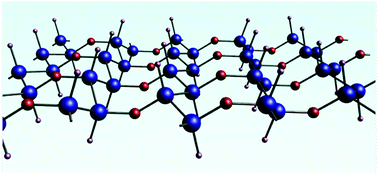Structural stability and the electronic properties of a (SiH)2O-formed siloxene sheet: a computational study†
Abstract
Very recently, a (SiH)2O-formed siloxene sheet has been synthesized in an experiment [S. Li, et al. J. Mater. Chem. A 2016, 4, 15841]. Utilizing first-principles calculations, we have systematically investigated the structural stability and the physical properties of this (SiH)2O sheet. We have found a dynamically stable structure because it is a puckered one with bent Si–O–Si connections, which leads to an anisotropic elastic behaviour with negative Poisson ratios. The (SiH)2O sheet has a strain-tunable direct band gap whose valence and conduction band edges straddle the redox potentials of water even in the presence of stress (either tensile or compressive). The calculated carrier mobilities are prominently anisotropic: in its zigzag direction the electron mobility reaches a high value of 5.39 × 103 cm2 V−1 s−1, while the hole mobility remains small. These different carrier mobilities permit fast charge separation and transfer, which is crucial for efficient solar-to-electric energy conversion for photovoltaic and water splitting applications. Similar to phosphorene, a typical linear dichroism phenomenon is also present in the (SiH)2O sheet. Due to its outstanding electronic properties, the (SiH)2O sheet is a promising material in the fields of nano-electronics, sustainable energy and fuel generation.



 Please wait while we load your content...
Please wait while we load your content...